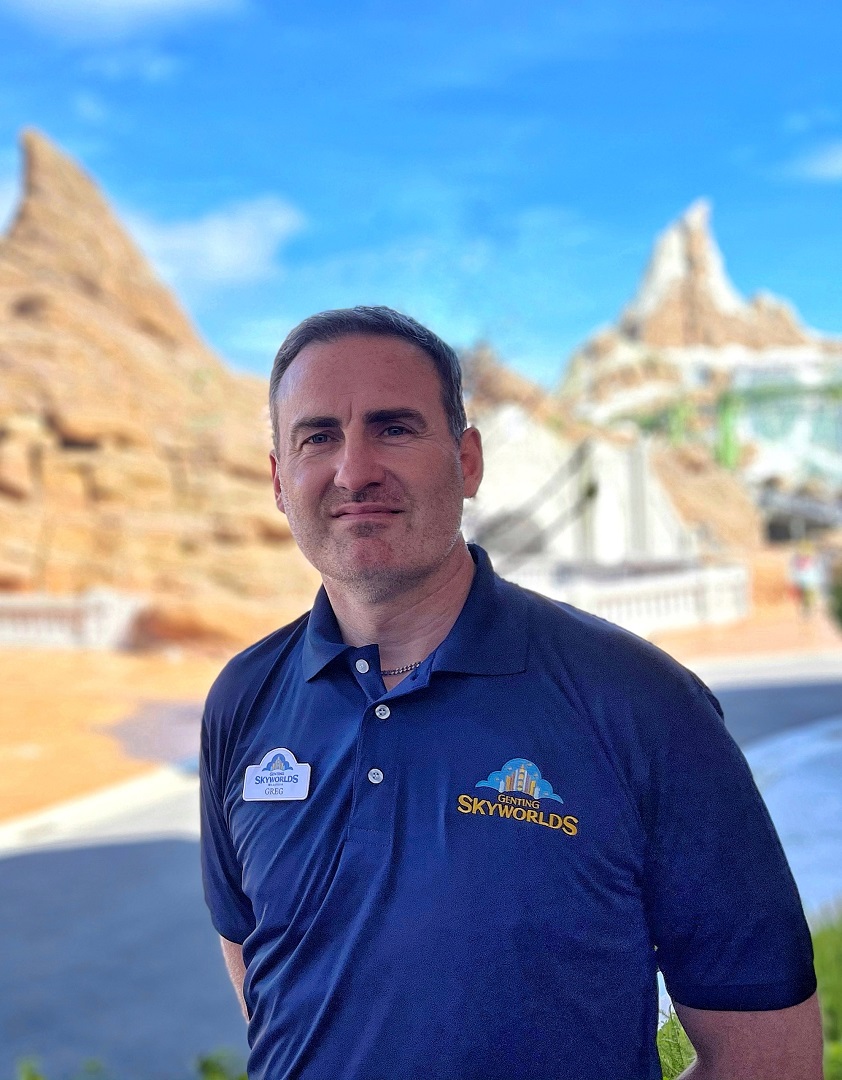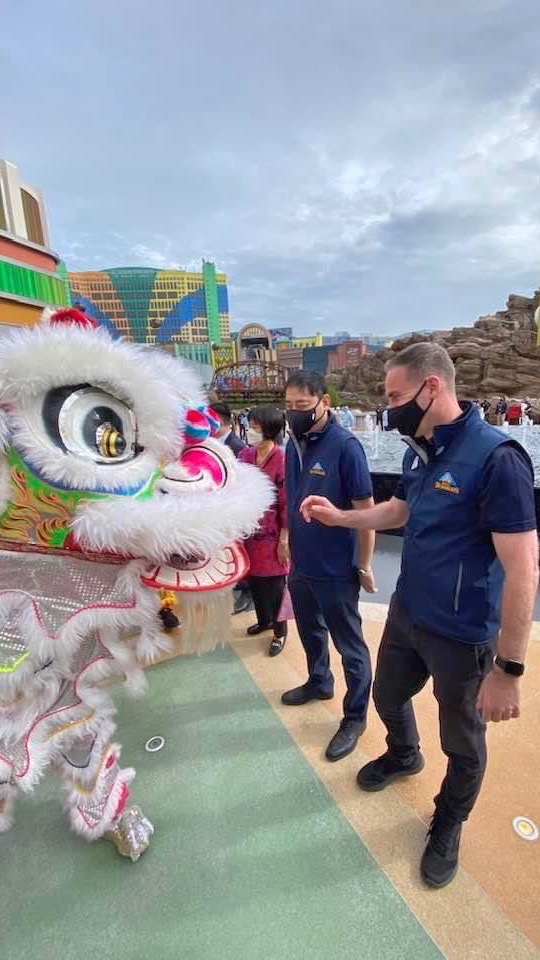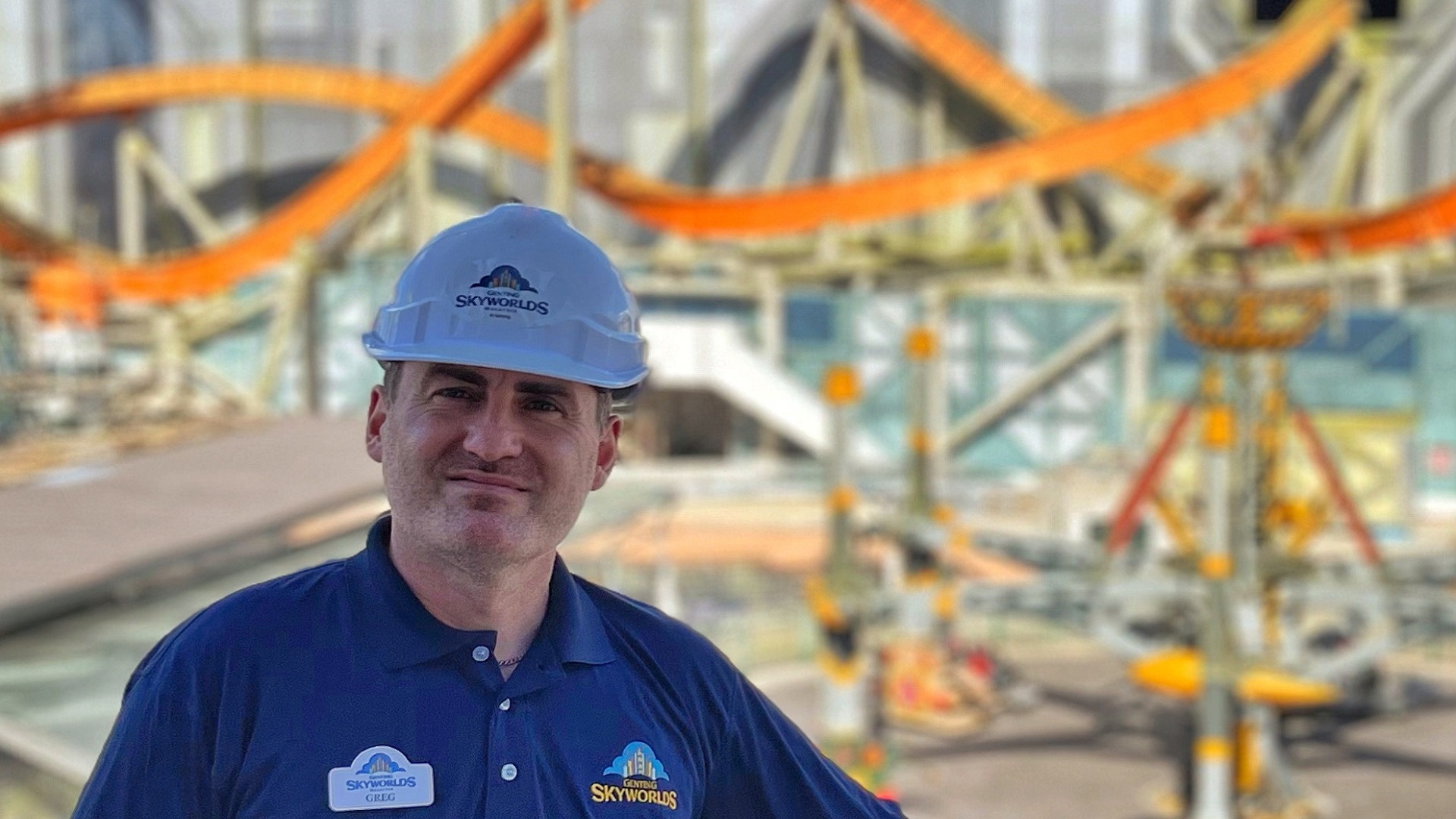
The professional we present started his career in marketing, went through operations at Deep Sea Leisure or Merlin Entertainments, to reach the vice-presidency of theme parks at Resort World Genting. He started working in the UK, moved on to Dubai and then Malaysia. He made his mark in organizations focused on educational and knowledge experiences and also in others dedicated to entertainment. He has managed the largest collection of sharks in Europe, emblematic places such as the Madame Tussauds wax museum or one of the oldest circuses in the world. The results of his work have always backed him up. Don’t miss this exciting conversation with Greg Pearn.
Amusement Logic: What was it that brought you to the leisure industry and how did it happen?
Greg Pearn: I recall from an early age my parents taking my brother and I to Alton Towers, a fledgling theme park 1 hour from our home in the UK. It was 1980. I was 6 years old, and the Corkscrew (Vekoma) rollercoaster was the must-do new attraction. I took one ride and was instantly captivated. From that moment onwards, Alton Towers was a yearly visit, increasing in frequency as I got older, and I knew that the business of fun was going to be my career, one way or another.
In later years I was involved with Blackpool Pleasure Beach and their enthusiast’s organisation. Through those connections I knew the Pleasure Beach team well and one day, out of the blue, a former employee of theirs called me up and asked if I’d like to work with her at Blue Planet Aquarium. That was my foot in the door and I never looked back since.
A.L.: Your first job in the sector was at the Marketing Dept. in Deep Sea Leisure, owner society of Blue Planet Aquarium and Deep Sea World. How did these venues work and how did you achieve 18% growth in visitor numbers and 20% growth in revenue?
G.P.: At the time, Blue Planet was the largest aquarium in the UK and a new investment for Deep Sea Leisure, opening a year prior to my joining. The business was struggling to meet projections for several reasons, one of which was poor awareness within the competitive (and crowded) primary catchment area of Northwest UK. Growth was attributed to a rebranding of the attraction, repositioning as a ‘world-class’ family attraction with several USP’s including the largest collection of sharks in Europe, alongside a focused approach towards travel and tour partners, increasing the group segment and aligning pricing.
It was a team effort, and I would say my contribution was bringing focus to the product (the positives), improving the overall guest experience and introducing ideas to improve consumer touchpoints, internally and externally. Prior to my joining it would be fair to say the team was busy fire-fighting an unrealistic budget and pre-opening overspends that so often suffocate resources for a new build.
A.L.: You enrolled afterwards as Marketing Manager in the Science Discovery Centre known as Techniquest Glyndwr, and reached the General Manager position. What sort of attraction was it and how did your career there evolve?
G.P.: TQG was a family attraction with an educational focus, designed to enrich children’s knowledge of science, technology, engineering and maths using hands-on exhibits, live science shows, and educational sessions aligned to the national curriculum in England and Wales.
The attraction was a partnership between the Welsh Assembly Government, Techniquest Cardiff and Glyndwr University Wrexham. Working within the business from the pre-opening team delivering the branding, marketing and all the printed and digital collaterals (we were a hands-on small team and jack of all trades) through to general management of the business, its strategy and the politics of partnerships associated with government funding, was a fantastic learning curve, exposing me to large organisations, new learnings and key people that took my skill set to the next level.
A.L.: Then you became part of Merlin Entertainments team as Operations Manager and Head of Operations, first at Sea Life Aquarium, later at Madame Tussauds and finally at Blackpool Tower. How did the change from marketing to operations take place?
G.P.: I was head-hunted for a senior leadership position at the new Legoland Discovery Centre (LDC) Manchester. As it happened, Merlin understandably placed an in-house team (predominantly from Alton Towers) at that new opening, but offered me 3 opportunities within the wider group: GM positions at 2 of their SEA LIFE attractions and an Operations Manager role for SEA LIFE Blackpool (ironically, I got the call about Blackpool SEA LIFE opportunity as I was in the new SEA LIFE attraction at Alton Towers!).
Knowing Blackpool well and preempting Merlin’s operating contract for the Leisure Parc attractions (Blackpool Tower, Louis Tussauds, Golden Mile Centre) that were soon to be acquired by the local council, I chose Blackpool and spent several years working through the Midway cluster of attractions, from Operations at SEA LIFE and Madame Tussauds to Head of Operations at the Blackpool Tower, alongside working for the wider Merlin Entertainments Group on several key projects including the relocation of an Legoland Discovery Centre in Duisburg, Germany, and the pilot implementation of a new group-wide ticket system.
A.L.: What was working in such a mythical venue as the Madam Tussauds like and what were the intricacies of its operation?
G.P.: Fun! Honestly, until I worked at MT’s I never understood why guests would pay a premium to look at static wax figures of celebrities! But once immersed with the attraction and brand I enjoyed it immensely and worked with the team to continue the transformation of the attraction with new interactives, sets and revenue-generating experiences. We lifted MTBpl’s KPI’s to be one of the top performing attractions within the Merlin Group, consistently attracting a higher guest satisfaction score than the MT’s mothership in London. MTBpl was (and still is) a very successful attraction with relatively low operating costs and a strong profit margin, fueled by the UK’s obsession for celebrity culture.
The Blackpool MT’s was unique for Merlin since it was a transformation of an existing wax museum: Louis Tussauds Blackpool. The rebranding involved the replacement of most of the wax figures and the incorporating them within sets that were both interactive and accessible, allowing guests to get close and personal with their favourite stars. The refurbishment resulted in the closure of the original ‘chamber of horrors’ which remained in the basement of the attraction intact, only accessible to employees and was quite scary! We also removed an exhibition dedicated to human anatomy. During Louis Tussaud’s years this was an upsell and very popular part of the experience, but It was deemed off-brand for MT’s to have wax figures of male and female genitalia so had to go!
A.L.: What sort of attraction is Blackpool Tower?
G.P.: The Blackpool Tower is a 129-year-old Victorian entertainment complex spread over 7 floors with a magnificent mix of attractions and experiences ranging from the 150mtr tall observation tower (The Blackpool Tower Eye) to the beautiful Tower Ballroom and Tower Circus. There’s also a Tower Dungeon (Merlin’s Dungeon brand) which replaced what was the UK’s first public aquarium and other smaller attractions, F&B and commercial opportunities within the complex. In essence there is something for everyone within the complex, but my personal highlight was the Blackpool Tower Circus, one of the oldest circus arenas in continuous operation and one of only a handful featuring a submersible stage that filled the circus ring with thousands of gallons of water for a spectacular show finale.
Managing the Circus was a highlight of my career and I would regularly spend the show interval working the kiosk supporting the front of house teams, not just to maximize sales, but mainly to enjoy the amazing guest feedback we would receive each performance. It was a real motivation boost and a reminder of why we do what we do, delivering unique experiences. The Tower Circus wasn’t always plain sailing though. Merlin Entertainments, who recently had taken over the management contract for the Tower, didn’t understand the Circus and the role it played within the Resort and nor did they like the perceived risks of acrobats and tightrope walkers! It wasn’t one of Merlin’s ‘brands’ and they made noises to close it. Pleased to say we pushed back and educated them on the significance of the show and I’m happy it continues to thrive. In my first year of managing the Circus we made it a profitable attraction and its relevance hasn’t been questioned since.


A.L.: Then you traveled to Dubai first and to Malaysia afterwards, to finally be part of Resorts World Genting. What is the difference between Dubai’s market and that of Malaysia?
G.P.: Dubai’s demographic is more diverse than Malaysia, with a greater international mix which is understandable since the Emirati population was about 14% of the UAE’s total population.
Genting’s demographic is predominantly Malaysian, pre-pandemic about 70% followed by Singapore at 10% and the rest came from Southeast Asia, China and the rest of the world. Of the Malaysian mix there is a split between Malay and Malaysian Chinese, of which the latter would be the gaming consumer. 95% of Resorts World Genting’s (RWG) revenue came from gaming operations despite the 5% from leisure and hospitality being a significant contributor. Gaming had a lot of focus…!
A.L.: What is Resorts World Genting, what are its assets and what do they offer to visitors?
G.P.: RWG is an integrated gaming resort – a mini city located 6,000ft on top of a mountain about 1 hours’ drive from Malaysia’s capital city, Kuala Lumpur. The resort is nestled within a stunning 250-million-year-old tropical rainforest and on a clear day the views are breathtaking.
In 2019 we welcomed 29 million guests. Our cable car alone transported just shy of 9 million guests with an 85% profit margin. Big business. At the top of the mountain there are over 10,500 keys with average year-round occupancy at 97% including the world’s largest hotel, First World. The resort has an extensive mix of gaming, retail, dining, entertainment, attractions and hospitality. It is a unique proposition that must be experienced to be believed. There is also a 150-store premium outlet village, an 18-hole championship golf course with its own hotel, 14,000 acres of rainforest and a significant amount of infrastructure to support daily operations and over 14,000 employees that lived and worked on property.
There wasn’t a week that passed that I wouldn’t be amazed by the size and scale of operation we had, especially during key trading with crowds of 150k daily.
A.L.: How was it that in just a year and a half you went from the position of Assistant to the Vice President to Vice President of Theme Parks in Resorts World Genting?
G.P.: I built a team that delivered results. I joined the business at a pivotal time for the Theme Park division. We were redeveloping the indoor theme park Skytropolis (20 plus rides indoors) whilst working through some challenges with the outdoor theme park 20th Century Fox World, alongside opening new attractions including The VOID hyper VR and SKY VR as well as expanding existing assets to improve guest experience and revenue. It was a busy time off the back of significant capex investment to improve the overall resort. I was passionate about the product and developing a team to deliver the best experiences to the highest safety and operational standards and ultimately I was rewarded for exceeding expectations. It was a great time to be on the mountain and incredibly rewarding for me personally.
February 2022 we opened Genting SkyWorlds: a well-documented theme park project that some speculated would never open! Nearly $1 billion USD of investment, some of it not that wisely spent in my opinion (for another interview!), the team and I achieved great things in turning around a poorly managed project, getting Disney onside (and exceeding their expectations) opening the park, but not only through significant contractual/partnership challenges, but also a global pandemic that hit Malaysia especially hard. Proud to say we delivered a safe world-class product to international standards. Despite the opening not being what I had planned (75% attraction availability due to project delays), we defied the odds and turned around a problematic project into a business that long-term will be successful if the focus remains on the standards and detail we had in place at opening. It’s a great park that has the potential, with the right leadership, to rival Universal Studios Singapore.
A.L.: You are now taking a rest to study for a Master in Hospitality Administration. Could you explain to us why you decided to do so?
G.P.: I was never the academic type, more of a dreamer, so I decided to take time out and focus on capturing my career experience within a formal certificate of recognition. Post pandemic-lockdowns I was also keen to catch up on 2 years of missed travel opportunities, which I’m pleased to say I’ve managed to do. The timing was right. June 2022 I was fortunate to land a new theme park opportunity with a tentative start date in 2023, so it just kind of worked out. No regrets.
A.L.: How do you see the future of the leisure industry in general and that of theme parks in particular?
G.P.: Theme parks are here to stay. Consumers want real, tangible experiences they can share emotionally with their friends and loved ones and through social via the multitude of media platforms offering instant recognition and bragging rights!
Technology will play an increasing part of the experience, from the traditional purchasing touchpoints to leveraging improved experiences with virtual queues, photography, interactivity, loyalty and commercial efficiencies. More parks will become resorts with added keys and multiple gates. Gaming IP’s will dwarf movie franchises and seasonal events will surpass regular ‘day’ operations.
It remains an incredibly exciting time to be in the industry as parks continue to evolve and new ride experiences push the boundaries alongside emerging mobile technologies that if done right, will play a significant role enhancing and complimenting the overall experience.
For these reasons and many more, I wouldn’t want to be in any other industry!
RELATED STORIES
Newsletter



